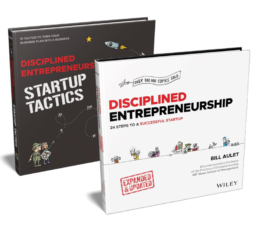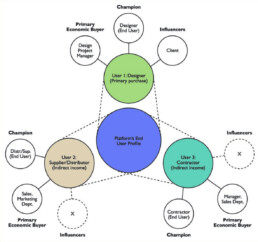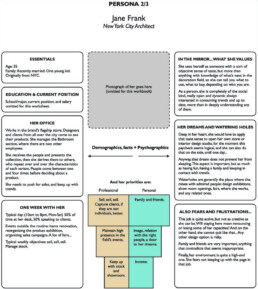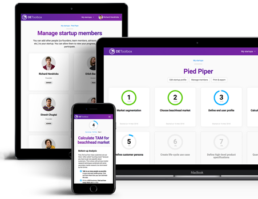Step 5
Beachhead Persona
The process of developing a Persona provides specific details about the primary customer within your Beachhead Market. You are now selling not to some composite “end user profile”, but to a specific individual.
Your whole team should be involved in this process to ensure everyone is on the same page and truly understands the Persona, so they can maintain a customer-based focus. An important detail to understand about the Persona is his or her purchasing criteria in prioritized order. You should really understand your customer and what makes them tick, not just at a rational level, but at an emotional and social level as well. The better you understand your Persona’s needs, behaviors, and motivations, the more successful you will be at making a product and a new venture to serve them. Once you have made a picture or visual of your Persona and fleshed out the fact sheet, make it all visible within your business so that everyone on your team works toward the same common goal.
Videos
Worksheets
Examples
Content will be published as it becomes available.
Topics
Process Guide
To create the Persona profile, see Worksheets 5.1 and 5.2 in this section, the General Information on Persona and the Persona Profile for Beachhead Market, which will step you through the information you need to consider in your profile. You may find additional information becomes relevant or some of the fields on the worksheet are not relevant. Make a profile that fits your Persona.
In addition, here are some things to consider when building your Persona:
- It must be a real person.
- Make it visual and omnipresent. Your Persona won’t motivate people if it’s a few paragraphs of text sitting on a dusty shelf.
- Specificity is good. Definitely err on the side of too much detail rather than too little, especially at first, but then remove the details that don’t add value.
- It is very important to do this as a team exercise.
Once you have the Persona, you will start to focus on what you can do to add value for that Persona.
Persona Profiles for Multisided End User Market
How do you build a Persona profile when you have multiple types of end users for your startup, such as with the increasingly common platforms being built today? The fundamental concept is the same, designating one Persona for each type of end-user, but the Persona profiles must be coordinated and consistent with each other.
Awa Kone, Jeronimo van Schendel, Lisa Tacoronte, and Benedita Sampaio e Mello took my class at MIT and worked on a project to create a platform, dubbed “BuildLine,” to help designers, contractors, and suppliers to better collaborate when turning ideas into tangible products by making relevant peer connections and facilitating the project management process.
While the team had some significant domain expertise in this field, they chose wisely to make the Personas people other than themselves. You will see excellent Personas for all three sides of the proposed new venture (but not perfect, as they never are, especially for a one-semester course where so much has to be covered).
You’ll notice how they handled and coordinated all three sides of the end user market. I really like the detail summarized in one slide for each Persona, so you get a rich understanding of each Persona and can quickly determine what is most important to each, which is highly beneficial when you have to make decisions keeping three Personas in mind instead of just one.
I would have liked to see more product proxies and watering holes, and at times I felt like their profiles veered more toward advocacy for the product as opposed to focusing solely on understanding who the Personas are, but all in all, they did a tremendous job!
First, Figure 5.6 is an overview of the players in BuildLine.
Books
Content will be published as it becomes available.
Other Resources
Content will be published as it becomes available.
The Disciplined Entrepreneurship Toolbox
Stay ahead by using the 24 steps together with your team, mentors, and investors.
The books
This methodology with 24 steps and 15 tactics was created at MIT to help you translate your technology or idea into innovative new products. The books were designed for first-time and repeat entrepreneurs so that they can build great ventures.





